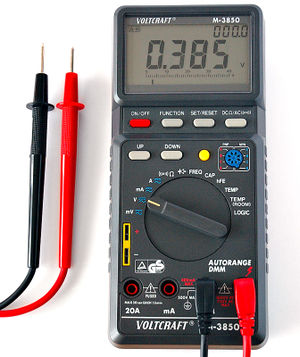Multimeter

A multimeter is a device which measures electric current, resistance, and voltage (provided it's attached to an electric circuit properly). It comes in analog and digital forms, but both function the same basic way.[2] A multimeter possesses the capability of a voltmeter, ammeter, and ohmmeter. To see how a multimeter can switch between these readings please see hyperphysics.
Voltmeter
The voltmeter is connected across a component; in other words, two voltmeter leads are connected to two sides of the component, so a voltmeter is in parallel with the component. When a voltmeter is connected across a component it completes the circuit. A small amount of current is generated in the circuit, which then causes a voltage drop across each of the other resistors. This leads to a voltage reading by the voltmeter that is slightly lower than the source voltage.[3][4] To learn more please see hyperphysics.
Ammeter
In order to use an ammeter, the current path must be broken and the ammeter is inserted across the break[3] (this means that ammeters must be in series with what is to be measured). If an ammeter is put in parallel with a circuit (instead of putting it in series), the current will almost certainly blow the fuse! It's much easier to blow a fuse with an ammeter than with a voltmeter because ammeters have very low resistance.
Clamp-on meters can be used to measure AC without breaking the conduction path. As an AC passes through the conductor, a magnetic field is formed around it; by measuring the magnetic field strength around the conductor, the current value can be obtained.[3] To learn more please see hyperphysics.
Ohmmeter
The safest way to connect the ohmmeter is to remove the component from the circuit and then connect it across the component like with the voltmeter. It is important to hold only one of the component leads because the resistance of human skin can affect the measurement.[3] To learn more please see hyperphysics.
For a tutorial on how to use a multimeter please see NCSSM (the North Carolina School of Science and Mathematics).
References
- ↑ Wikimedia Commons. (September 23, 2015). Multimeter [Online]. Available: https://upload.wikimedia.org/wikipedia/commons/a/a6/Digital_Multimeter_Aka.jpg
- ↑ R.T. Paynter, “Basic Electric Components and Meters,” in Introduction to Electricity, 1rst ed. NJ: Prentice-Hall, 2011, ch. 3, sec. 3.7, pp. 107-116.
- ↑ 3.0 3.1 3.2 3.3 R.T. Paynter, “Basic Electric Components and Meters,” in Introduction to Electricity, 1rst ed. NJ: Prentice-Hall, 2011, ch. 3, sec. 3.8, pp. 117-121.
- ↑ R.T. Paynter, “Basic Electric Components and Meters,” in Introduction to Electricity, 1rst ed. NJ: Prentice-Hall, 2011, ch. 5, sec. 5.4, pp. 201-208.

